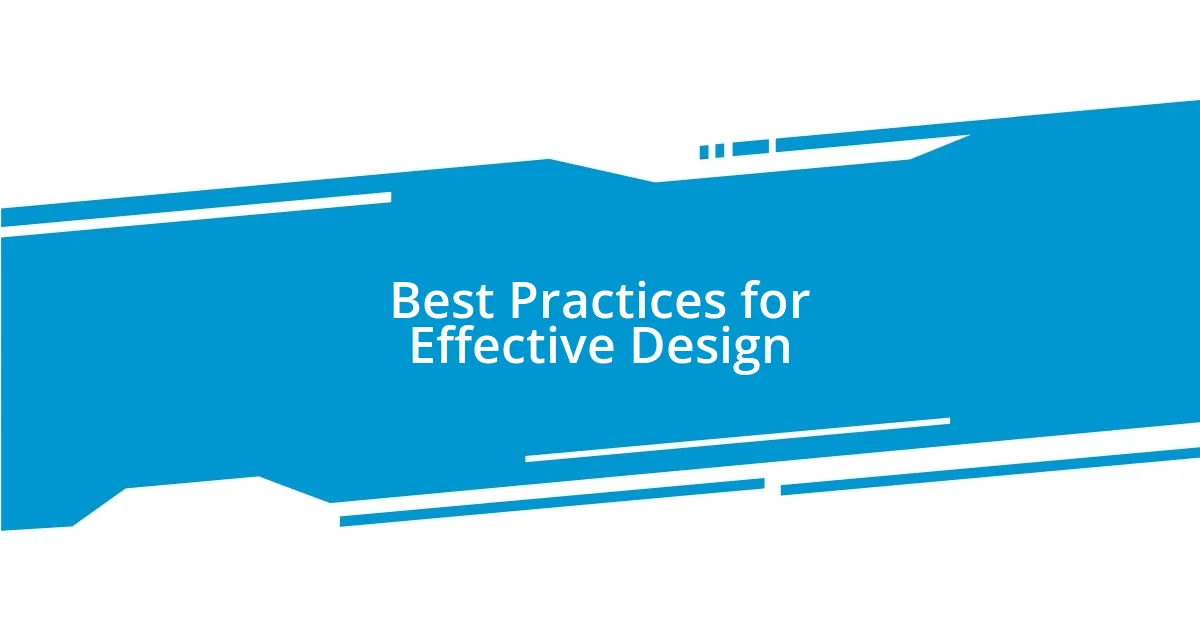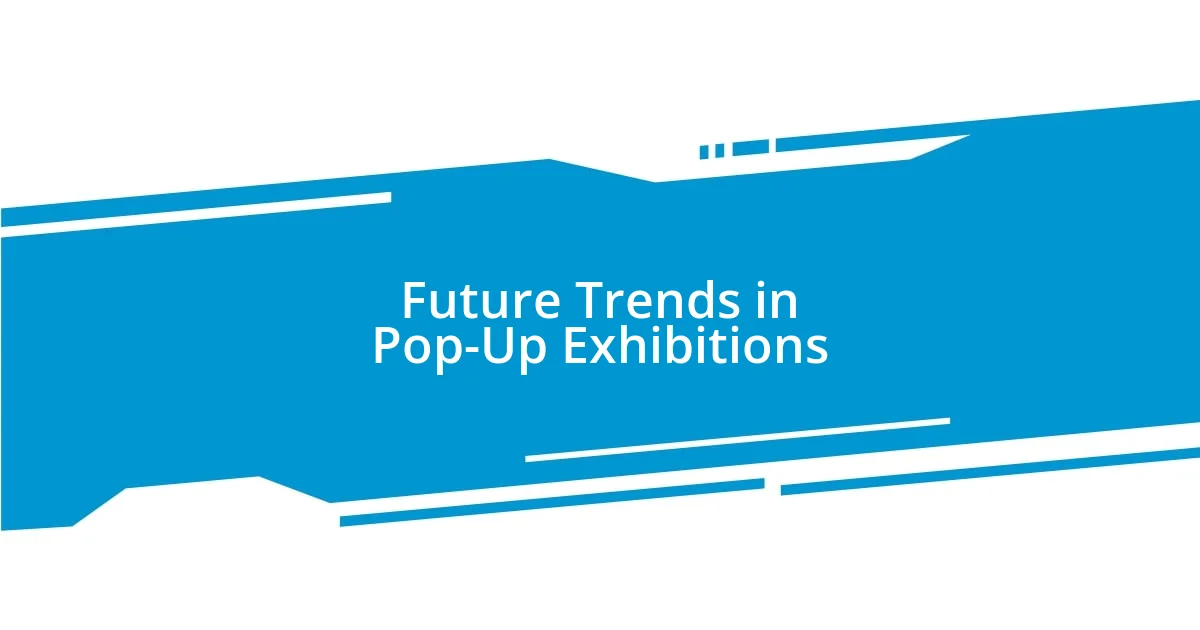Key takeaways:
- Pop-up exhibitions create unique, fleeting experiences in unconventional spaces, fostering community engagement and making art more accessible.
- Challenges in hosting these exhibitions include securing venues, managing logistics, and effectively marketing in a limited timeframe.
- Future trends suggest a shift towards immersive, technology-driven experiences, sustainability, and increased community involvement in the exhibition process.

Understanding Pop-Up Exhibitions
Pop-up exhibitions are temporary showcases, often set up in unconventional spaces, where art and creativity come to life in a fresh, engaging way. I remember attending a pop-up in an abandoned warehouse; the juxtaposition of the raw setting and vibrant artwork created a unique atmosphere that felt alive with possibilities. Isn’t it fascinating how these installations can transform ordinary locations into extraordinary experiences?
The beauty of a pop-up is its fleeting nature. There’s something bittersweet about knowing that the exhibit will only be around for a short time, which can provoke a sense of urgency in visitors. I often find myself drawn to events like these because they create an intimate connection between the audience, the artists, and the environment, leading to conversations that are as spontaneous as the exhibitions themselves.
Additionally, these exhibitions often cater to local communities, making art accessible to a broader audience. In my experience, I’ve seen how pop-ups can spark interest in arts among those who might not typically visit galleries. Isn’t it rewarding to see local talent shine in unexpected ways? Each event invites attendees to not only witness art but to become part of a living story that unfolds within the community’s fabric.

Benefits of Pop-Up Exhibitions
Pop-up exhibitions offer a unique opportunity for artists to showcase their work without the constraints of traditional gallery spaces. I recall attending a pop-up exhibition in a quaint café, where the scent of freshly brewed coffee mingled with vibrant paintings. This casual setting not only made the art more approachable but also fostered connections among artists and attendees, creating an informal community atmosphere that felt warm and welcoming.
One standout benefit of pop-ups is their ability to experiment and innovate. Artists often use these temporary venues as a testing ground for new ideas or concepts that push the boundaries of conventional art forms. I’ve been fascinated by instances where creators use unconventional materials or digital elements in their work, inviting visitors to engage in interactive experiences. These exhibitions not only challenge the norms but also encourage audience participation, making the experience memorable.
Moreover, the limited-time nature of pop-ups often drives a sense of urgency among potential visitors. I distinctly remember when a pop-up aimed at raising awareness for environmental issues only lasted a weekend. The thrill of knowing I had to seize the moment heightened my appreciation for the art and the cause behind it. This urgency can lead to increased foot traffic and buzz, making the exhibition a talking point long after it closes.
| Benefit | Description |
|---|---|
| Accessibility | Pop-ups engage local communities, making art more approachable and inviting to those who may not typically visit galleries. |
| Innovation | These exhibitions allow artists to experiment with new ideas in unconventional settings, fostering creativity and interactive experiences. |
| Urgency | The temporary nature of pop-ups creates an intriguing urgency for visitors, often resulting in heightened interest and foot traffic. |

Challenges in Hosting Pop-Up Exhibitions
Hosting pop-up exhibitions comes with its fair share of challenges that can sometimes dim the excitement surrounding them. One of the biggest hurdles is securing the perfect venue. I remember a pop-up that struggled to find a space; the ideal location had already been booked for months. This led to a last-minute scramble, which can dampen the enthusiasm of both the organizers and the artists. Preparing a suitable environment to showcase the artwork is essential, and when things fall through, it can feel overwhelming.
Here are some key challenges faced while hosting pop-up exhibitions:
- Logistics: Coordinating setup and breakdown times can be tricky, especially in shared or temporary spaces.
- Funding: Many pop-ups operate on tight budgets, making financial planning and securing sponsorships crucial yet challenging.
- Marketing: With limited time to promote, reaching the target audience effectively becomes a daunting task.
- Community Engagement: Ensuring that the exhibition resonates with the local community requires thoughtful planning and effort.
- Legalities: Navigating permits, insurance, and other legal requirements can be complex and often overlooked.
On a different note, managing unpredictable visitor turnout is also a significant challenge. I experienced this firsthand at a pop-up where attendance fluctuated wildly from one day to the next. We prepared for a crowd based on initial interest, only to find ourselves with a sparse turnout on a rainy Saturday. It highlighted how dynamic and sometimes uncontrollable the nature of these exhibitions can be.

Best Practices for Effective Design
When it comes to designing a pop-up exhibition, clarity of purpose is crucial. I often find that each element of the exhibition should be intentional and aligned with the theme. For instance, at one pop-up I visited, every piece of art directly connected with the narrative being shared, creating a coherent experience that kept visitors engaged. Can you imagine walking into an exhibition where nothing seemed to fit? It can feel off-putting and disengaging.
Lighting plays a vital role in the atmosphere of an exhibition. I recall a pop-up that used soft, warm lights to create a cozy environment, drawing visitors in and making them linger. Conversely, I’ve seen spaces poorly lit, leaving stunning artworks in shadows and failing to showcase their beauty. It just goes to show how thoughtful lighting can enhance or detract from the overall experience.
Interactive elements can elevate a pop-up exhibition to new heights. When I attended a show that incorporated augmented reality, I was completely immersed in the artwork. Each piece came alive with my smartphone, allowing a deeper understanding of the creator’s intent. Don’t you think this kind of interaction can make art more relatable? Incorporating such elements encourages dialogue between the art and the audience, transforming passive observation into an active experience.

Promoting Your Pop-Up Exhibition
Promoting a pop-up exhibition effectively can sometimes feel like a whirlwind of tasks. One tactic that I’ve found success with is creating buzz on social media platforms. I remember launching an event where short video clips showcasing the featured artists caught people’s attention. The excitement was palpable as engagement skyrocketed, resulting in a turnout that exceeded our expectations. Have you considered how effective behind-the-scenes content can be in drawing in an audience? It truly gives a personal touch.
Another strategy is collaboration with local businesses and influencers. I once partnered with a coffee shop nearby, which agreed to display one of the artists’ pieces leading up to the event. It generated cross-promotion that benefited both parties. Can you see the potential in such partnerships? Not only does it expand reach, but it also fosters a sense of community involvement that can be incredibly motivating for attendees.
Email marketing shouldn’t be underestimated either. I tend to curate a targeted list of interested individuals who have engaged with past exhibitions. Personalized invites worked wonders once when I included a heartfelt note about the significance of the exhibition’s theme. It made those on the list feel special and more inclined to attend. Have you thought about how a simple email can rekindle interest and excitement? It’s about building relationships, and in the world of pop-ups, every connection counts.

Evaluating Success of Exhibitions
Measuring the success of a pop-up exhibition can sometimes feel a bit subjective, but I believe there are several key indicators to consider. For instance, I’ve seen the energy of the crowd as a telling sign. At one particular exhibition, the buzz of conversation and laughter indicated that visitors were not only engaging with the art but also with each other. Isn’t that kind of vibrant interaction a clear success?
Additionally, visitor feedback plays an essential role in evaluating success. After an exhibition I coordinated, I made it a point to collect informal reviews from attendees. I was surprised by the emotional depth of their responses—some spoke about how a particular piece had resonated with a personal experience. Can you imagine the impact that kind of response has on the artist and the purpose of the exhibition? It truly highlights how a successful exhibition extends beyond mere attendance; it’s about creating meaningful connections.
Lastly, I always look at the post-event metrics, like social media engagement and artist follow-ups. After one exhibition, our posts received overwhelming shares and comments, which was exciting to see. When artists gained new followers and connections as a result of the event, I felt like we had hit a home run. It’s these tangible outcomes that remind me just how important it is to measure success not just in numbers, but also in human connections and artistic impact. Wouldn’t you agree that those moments of connection can define the real victory in any exhibition?

Future Trends in Pop-Up Exhibitions
Pop-up exhibitions are evolving, and I foresee a trend towards immersive experiences that leverage technology. For example, I attended an exhibition where augmented reality allowed visitors to interact with the art in ways I never imagined possible. It added layers of meaning and depth, sparking conversations about the integration of art and technology. Have you thought about how these innovations can enrich the visitor experience?
Another exciting trend is the emphasis on sustainable practices. I remember a pop-up that focused exclusively on eco-friendly artists and materials. It wasn’t just about showcasing art; it fostered a meaningful discussion about our environmental impact. Doesn’t it feel inspiring to see art drive such important conversations? The future might see more exhibitions prioritizing sustainability, intertwining creative expression with social responsibility.
Moreover, I believe there will be an increase in community-centric pop-ups. A recent exhibition I organized involved local artists and involved the community in every step, from planning to execution. The turnout was heartwarming, as people felt a genuine sense of ownership and connection to the event. Could this community involvement be the key to creating lasting memories? I firmly believe that when people feel included, they are more likely to return and bring friends along next time.














